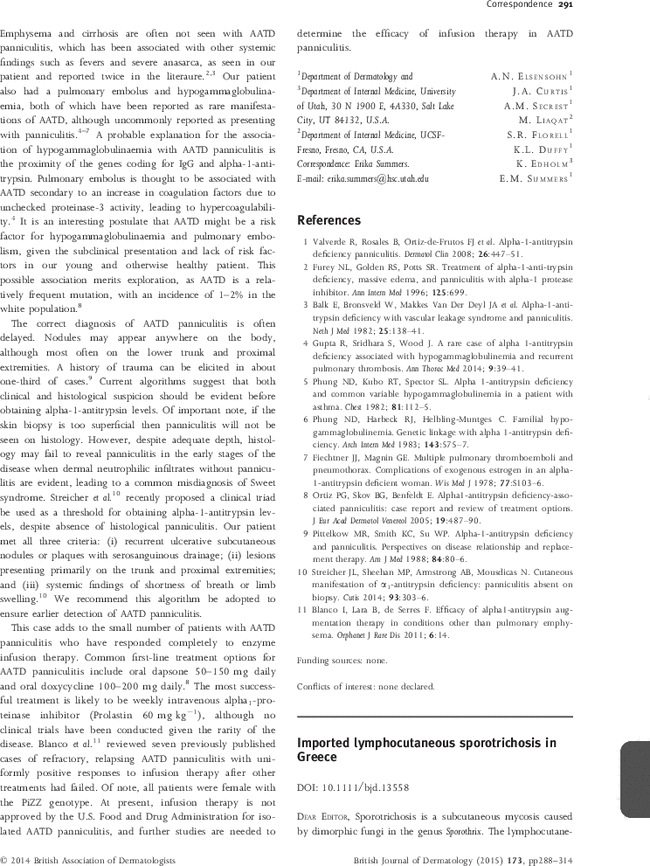Imported lymphocutaneous sporotrichosis in Greece
G. Xirotagaros
2nd Department of Dermatology Venereology, ‘Attikon’ Hospital, National and Kapodistrian University of Athens, Athens, Greece
Search for more papers by this authorM. Drogari-Apiranthitou
4th Department of Internal Medicine/Infectious Diseases Research Laboratory, ‘Attikon’ Hospital, National and Kapodistrian University of Athens, Athens, Greece
Search for more papers by this authorI.G. Panayiotides
2nd Department of Pathology, University of Athens Medical School, “Attikon” University Hospital, Athens, Greece
Search for more papers by this authorZ. Tsakiraki
2nd Department of Pathology, University of Athens Medical School, “Attikon” University Hospital, Athens, Greece
Search for more papers by this authorC. Tsamakis
2nd Department of Dermatology Venereology, ‘Attikon’ Hospital, National and Kapodistrian University of Athens, Athens, Greece
Search for more papers by this authorS. Theotokoglou
2nd Department of Dermatology Venereology, ‘Attikon’ Hospital, National and Kapodistrian University of Athens, Athens, Greece
Search for more papers by this authorP. Tofas
4th Department of Internal Medicine/Infectious Diseases Research Laboratory, ‘Attikon’ Hospital, National and Kapodistrian University of Athens, Athens, Greece
Search for more papers by this authorA.D. van Diepeningen
CBS-Knaw Fungal Biodiversity Centre, Utrecht, The Netherlands
Search for more papers by this authorG.S. de Hoog
CBS-Knaw Fungal Biodiversity Centre, Utrecht, The Netherlands
Search for more papers by this authorG. Petrikkos
4th Department of Internal Medicine/Infectious Diseases Research Laboratory, ‘Attikon’ Hospital, National and Kapodistrian University of Athens, Athens, Greece
Search for more papers by this authorD. Rigopoulos
2nd Department of Dermatology Venereology, ‘Attikon’ Hospital, National and Kapodistrian University of Athens, Athens, Greece
Search for more papers by this authorG. Xirotagaros
2nd Department of Dermatology Venereology, ‘Attikon’ Hospital, National and Kapodistrian University of Athens, Athens, Greece
Search for more papers by this authorM. Drogari-Apiranthitou
4th Department of Internal Medicine/Infectious Diseases Research Laboratory, ‘Attikon’ Hospital, National and Kapodistrian University of Athens, Athens, Greece
Search for more papers by this authorI.G. Panayiotides
2nd Department of Pathology, University of Athens Medical School, “Attikon” University Hospital, Athens, Greece
Search for more papers by this authorZ. Tsakiraki
2nd Department of Pathology, University of Athens Medical School, “Attikon” University Hospital, Athens, Greece
Search for more papers by this authorC. Tsamakis
2nd Department of Dermatology Venereology, ‘Attikon’ Hospital, National and Kapodistrian University of Athens, Athens, Greece
Search for more papers by this authorS. Theotokoglou
2nd Department of Dermatology Venereology, ‘Attikon’ Hospital, National and Kapodistrian University of Athens, Athens, Greece
Search for more papers by this authorP. Tofas
4th Department of Internal Medicine/Infectious Diseases Research Laboratory, ‘Attikon’ Hospital, National and Kapodistrian University of Athens, Athens, Greece
Search for more papers by this authorA.D. van Diepeningen
CBS-Knaw Fungal Biodiversity Centre, Utrecht, The Netherlands
Search for more papers by this authorG.S. de Hoog
CBS-Knaw Fungal Biodiversity Centre, Utrecht, The Netherlands
Search for more papers by this authorG. Petrikkos
4th Department of Internal Medicine/Infectious Diseases Research Laboratory, ‘Attikon’ Hospital, National and Kapodistrian University of Athens, Athens, Greece
Search for more papers by this authorD. Rigopoulos
2nd Department of Dermatology Venereology, ‘Attikon’ Hospital, National and Kapodistrian University of Athens, Athens, Greece
Search for more papers by this author
References
- 1Elewski BE, Hughey LC, Sobera JO, Hay R. Fungal diseases. In: Dermatology ( JL Bolognia, JL Jorizzo, JV Schaffer, eds), 3rd edn, Vol. 2. Philadelphia, PA: Elsevier Saunders, 2012; 1272–3.
- 2Zhang Y, Hagen F, Stielow B et al. Phylogeography and evolutionary patterns in Sporothrix spanning more than 14 000 human and animal case reports. Persoonia 2015; 35: 1–20.
- 3Neyra E, Fonteyne PA, Swinne D et al. Epidemiology of human sporotrichosis investigated by amplified fragment length polymorphism. J Clin Microbiol 2005; 43: 1348–52.
- 4Zhou X, Rodrigues AM, Feng P et al. Global ITS diversity in the Sporothrix schenckii complex. Fungal Divers 2013; 66: 153–65.
- 5Symmers WS. Sporotrichosis in Ireland. Ulster Med J 1968; 37: 85–101.
- 6Barile F, Mastrolonardo M, Loconsole F, Rantuccio F. Cutaneous sporotrichosis in the period 1978–1992 in the province of Bari, Apulia, Southern Italy. Mycoses 1993; 36: 181–5.
- 7Criseo G, Malara G, Romeo O. Puglisi Guerra A. Lymphocutaneous sporotrichosis in an immunocompetent patient: a case report from extreme southern Italy. Mycopathologia 2008; 166: 159–62.
- 8de Oliveira MM, Veríssimo C, Sabino R et al. First autochthone case of sporotrichosis by Sporothrix globosa in Portugal. Diagn Microbiol Infect Dis 2014; 78: 388–90.
- 9Dias NM, Oliveira MM, Santos C et al. Sporotrichosis caused by Sporothrix Mexicana, Portugal. Emerg Infect Dis 2011; 17: 1975–6.
- 10Ojeda T, Rodríguez-Pichardo A, Suárez AI, Camacho FM. Sporotrichosis in Seville (Spain). Enferm Infecc Microbiol Clin 2011; 29: 233–4.
- 11Magand F, Perrot JL, Cambazard F et al. Autochthonous cutaneous sporotrichosis in France. Ann Dermatol Venereol 2009; 136: 273–5.




